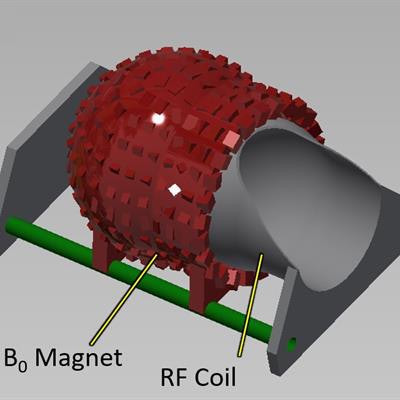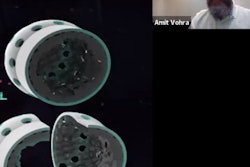
The ability to perform a whole-brain MRI scan at the point of care for patients with mobility challenges could soon become a reality with a portable, lightweight device now under development by researchers at the Massachusetts Institute of Technology (MIT) in Cambridge, MA.
The low-field, helmet-like scanner could overcome large-scale financial investments and structural requirements of siting conventional, long-bore, 1.5- and 3-tesla MRI systems. What's more, the developers believe the work-in-progress system will ultimately yield diagnostic-quality images and enable healthy outcomes for patients.
"This [device] is built on a large body of work, with innovation and a design that is focused on an appropriate size that fits around an adult's head," said co-developer Patrick McDaniel, a doctoral student in MIT's electrical engineering program. "It is optimized for this application because it is a very large area of clinical MRI. That is where this particular work fits into this bigger picture of portable and lower-cost systems."
MRI's limitations
Stationary, conventional MRI scanners are not very accommodating for bedridden patients with mobility issues. To help alleviate this roadblock, researchers have long sought to develop smaller, portable devices to image extremities and other body regions. Redesigning components and reconfiguring hardware requirements can be a slow and arduous process, but the end result of a low-cost, portable system is worth the laborious effort.
MIT researchers began this project to scale down MRI technology back in 2010, led by principal investigator Larry Wald, PhD. Speaking with AuntMinnie.com at the 2019 International Society for Magnetic Resonance in Medicine (ISMRM) annual meeting in Montreal, Wald said he, McDaniel, and their MIT colleagues are attempting a "quantum leap to handheld devices" for MRI -- similar to the evolution and redesign of other modalities, including ultrasound.
By 2017, the researchers developed a second iteration of their compact whole-brain magnet, complete with gradient and radiofrequency (RF) coils, as well as other components to perform scans on healthy human subjects.
The MR images produced by the second-generation device were encouraging. McDaniel compared the results to T2-weighted and turbo spin-echo images, adding that secondhand opinions from various radiologists declared the images were "pretty good." He stopped short of making any claims regarding the diagnostic quality of the images, except to say they "internally were received very well."
However, image artifacts did present in certain parts of the brain that the second-generation device could not rectify. The images were "squished together, stretched out, or blurred," McDaniel added. "So that was something we hope to be able to address and mitigate in this third iteration."
Design modifications
A conventional, whole-body MRI scanner has a uniform magnetic field and gradient coils to handle MR image coding. Similarly, the current third iteration of this work-in-progress scanner is designed to have a more uniform magnetic field for image coding.
"The reason is the flexibility that we get when we do image coding with these gradient coils. It allows us to reconstruct and create better images," McDaniel explained. "One issue that we ran into was imaging artifacts, sometimes due to the limitations of the second iteration. We hope that using this more flexible image coding approach will allow us to generate images with fewer artifacts."
In addition, the technology's third version is smaller and lighter than its preceding prototype and is designed to not sacrifice head imaging performance. The third-generation system is a standalone, helmet-shaped scanner that includes a magnet and coils just like the essential hardware on a conventional MRI scanner -- only much smaller.
 Design of a standalone, whole-brain MRI scanner and gradient assembly (A) being developed by researchers at MIT. A conceptual drawing (B) removes the gradient coils to show the head-only magnet and RF coil. Images courtesy of Patrick McDaniel and ISMRM.
Design of a standalone, whole-brain MRI scanner and gradient assembly (A) being developed by researchers at MIT. A conceptual drawing (B) removes the gradient coils to show the head-only magnet and RF coil. Images courtesy of Patrick McDaniel and ISMRM.When completed, the device is expected to weigh approximately 75 pounds with an outer diameter of approximately 37 cm and length of 37 cm. The inner dimension is closer to 25 cm, which would accommodate a slightly above average-size human head. The device stays stationary, so a patient would slide into the helmet for scanning.
The magnet strength is 72 millitesla, which equals 0.072 tesla. That low-field magnet certainly is much less than current conventional MRI systems. So, what kind of images could clinicians reliably expect?
"Obviously, we would not get as strong an [MRI] signal at this field strength, and that limits the resolution we are able to image," McDaniel said. "If we try to get 1 mm x 1 mm x 1 mm images, they would not look very good. If we can relax that resolution requirement, we can get MR images at a size of 2 mm x 2 mm x 5 mm as a reference resolution and working standard. That is what we have in mind, but there is a flexible tradeoff between how noisy the images [are] and how high the resolution is."
Currently, the researchers are still in the design and materials purchase phase of the project, but a working prototype could be available as soon as the end of this year. Assuming that target date is accomplished, McDaniel and colleagues hope to begin scanning phantoms or healthy subjects in early 2020.
How might this portable device help in the clinical setting? Based on the MR images acquired by the second-iteration magnet, the researchers could clearly see cerebrospinal fluid and ventricles in the brains of healthy subjects. That leads them to think the technology also could detect anomalies such as hematomas or hydrocephalus, a task that would not necessarily require high-resolution scans.
"We also see this [device] potentially used where it may be cost-prohibitive to install a full-size conventional MRI scanner," McDaniel added, such as a "rural area where the economics do not support an expensive commercial system or a developing third-world setting."


.fFmgij6Hin.png?auto=compress%2Cformat&fit=crop&h=100&q=70&w=100)





.fFmgij6Hin.png?auto=compress%2Cformat&fit=crop&h=167&q=70&w=250)











